

copyright 2007 by George Johnson
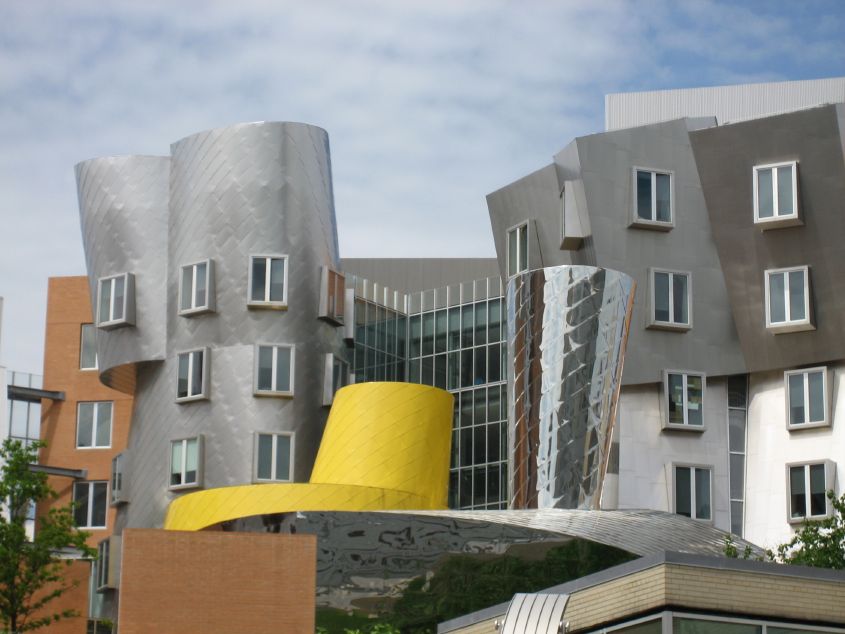
Stata Center, Massachusetts Institute of Technology, photo by George Johnson, copyright 2007
1. Retrofit Arithmetic (and Rainbarrel Economics)
2. The San Juan-Chama Shell Game
3. The Case of the Disappearing Aquifer
4. The Creative Hydrology of Suerte del Sur
5. The City, the County, and a Water Tax Revolt
6. Water Numerology at City Hall
(Our story thus far)
7. The Woman at Otowi Gauge
8. "Forget it, Jake. It's Chinatown."
9. The Las Campanas Connection
(Our story continues)
10. The Engineering Solution
June 12, 2007
42. Buying Back the River
I was driving up East Alameda last week with my friend John Horgan, an author of national repute, conversing about the talks we'd heard that day at the Santa Fe Institute: the science of AIDS, the search for the origins of life -- topics that our students were confronting at this year's Santa Fe Science Writing Workshop. On our right water was cascading over the falls near Camino Escondido, on its way to the Delgado Street bridge. Just as we were approaching Patrick Smith Park, John suddenly exclaimed, "Man, this is beautiful." I felt proud to be a Santa Fean, almost forgetting that the flow we were admiring was just a meteorological fluke.
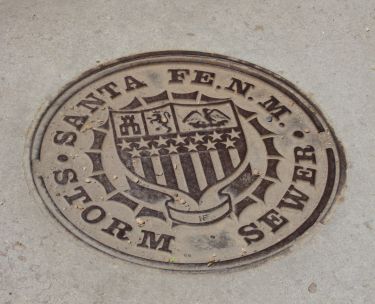
Within days, according to this morning's New Mexican, the city will turn off the river again, diverting it into the ever expanding labyrinth of the city plumbing system. With only so much water to go around, first dibs go to the Kurt Youngs and the Wally Chapmans, to the Centex Corporation, to the new Wal-Mart . . . If the rest of you want water for the river then, by God, you'll just have to buy it yourself.
That is the unintended message of the city's new River Fund plan, encouraging citizens to add a few extra dollars to their monthly utility bills for acquiring environmental water rights.
Because of this winter's freak blizzards and the unseasonable spring rains, the city has been reluctantly letting almost 10 acre-feet a day through the dams (5 cubic feet per second), creating a flow extending to Frenchy's Field, San Ysidro Crossing and beyond. With water rights selling for $20,000 an acre-foot, keeping that going would cost $6 million a month. The city says it will match donations, so if each of the 35,000 metered water customers pledged $50 a month, the maximum allowed, we'd be more than halfway home.
In truth City Hall has nowhere near the money it would need to match the tens of millions of dollars that would ensure a constant flow. And it knows it won't have to. No matter how admirable the cause, voluntary check-off programs like this draw only minimal participation. The danger is that, like the toilet retrofit program, it will become a diversion, creating the illusion that Santa Fe is serious about restoring its river when water is really being managed with one overriding goal -- accommodating development. With no controls on growth, the dollars we give to the River Fund -- like the gallons we save through conservation -- will just free up water for more new houses, subsidizing the construction and real estate industries.
Thornburg
While I was away the other big news was the City Council's approval of the Thornburg tax subsidy. But the matter of whether the new corporate headquarters can be legally built remains unclear. District Judge Jim Hall decided at a hearing on May 25 (here is the transcript) that Concerned Residents of Santa Fe North Inc. has no standing to enforce the covenants -- it does not, as an entity, own property in Santa Fe Estates, though all of its members do -- but he refused to summarily dismiss the group's lawsuit. Ruling that the issue of whether Mr. Thornburg's blueprints comply with Santa Fe style has yet to be decided, the court left open the possibility that the neighborhood association can substitute a new plaintiff. The result would be the class-action suit by property owners hinted at in the organization's recent full-page ad in the New Mexican. (Please see the entry here for May 18, Trojan Horse Trading.) As the proud new owner of the land on which the Thornburg Companies will soon break ground, the City of Santa Fe would surely be among the defendants. Maybe another checkoff box can be added to our utility bills should any of Mr. Thornburg's avid supporters want to contribute to the legal fund.

Postscript
The Reporter's annual Best of Santa Fe contest includes a category for best blog, and one of the choices is The Santa Fe Review. I am not sure this is really a blog, but your vote would be most appreciated. Here is the link: https://vovici.com/wsb.dll/s/2267g28e68. The deadline is this Wednesday, June 6.
June 12, 2007
The Graffiti Mess
Around Buckman Road, near Camino de Los Montoyas, is what is beginning to resemble a Mad Max wasteland. Graffiti has been sprayed across the face of almost every city traffic sign, on Qwest's ubiquitous telephone junction boxes, on posts and fences. Even the rocks have been vandalized. The city might as well post an invitation: "Welcome to the lawless zone."
It was here last month that a young Santa Fe dropout, who had apparently learned to respect neither private property nor the laws of electricity, tragically electrocuted himself as he tried to spray his tag on a 115,000-volt transformer. While responsibility for the sad outcome ultimately rests with the victim -- who died in a way nobody should, with third-degree burns covering his body -- PNM deserves a portion of the blame for allowing its station to become a haven for vandals.
"It's a big graffiti place," the young man, already dying, told the 911 operator as he called for help on his cell phone. Those were among his last words. His two companions, having witnessed the ultimate fame, fled once the emergency vehicles arrived.
Long before The Santa Fe Review, my entry into web publishing was sfgraffiti.com, an attempt to embarrass the Delgado administration into doing something about a vandalism epidemic that had left the Alameda looking at times like an inner-city slum. Since then there have been amendments to the graffiti ordinance and amendments to the amendments, but how very little has changed. The point then as now is that graffiti left in place is a magnet for more. The consequences are rarely so dire, but the kind of disrespect for the community shown by PNM, Qwest, and so many other local businesses is second only to that of the graffiti goons.
This bad corporate citizenship is not limited to the outskirts around the city transfer station. Look at the wall around this building at 417 E. Palace, in the heart of the Eastside historic district, owned and occupied by something called Santa Fe Realty Partners:
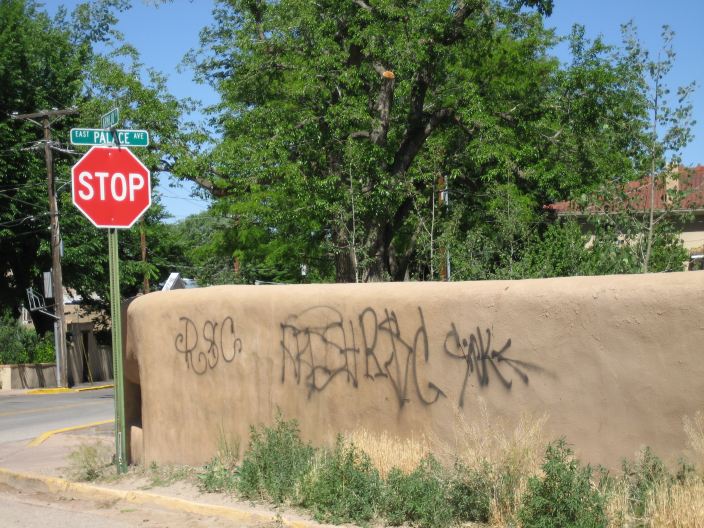
The scrawl has been there for at least two weeks. One would think that a company trying to profit from Santa Fe charm would recognize that as bad advertising.
The answer is not what one of the dead boy's relatives suggested, a city-sanctioned graffiti park where teens are free to express themselves with Krylon. The reason a tiny portion of Santa Fe's young people piss with paint on public and private property is precisely because it is illegal. The bigger the risk, the greater the fame. It's the same "fuck you" message that manifests itself in the sonic assault from automotive boom boxes: Nobody matters but me.

June 13, 2007
Postscript
I used to think that a great frontline defense in the graffiti wars would be Santa Fe's realtors. From a pure financial standpoint few others have such a stake in preserving property values. They are also out there every day on the frontlines driving the streets. How easy to pick up the cell phone and dial the graffiti hotline whenever they spot a vandalized wall or light pole, or to send a quick email when they get back to the office. Over the years I've suggested this to the director of the Santa Fe Association of Realtors and to a friend who was president of the organization for awhile. They couldn't have been less interested.
There is so much that could be done. The New Mexican could include small information boxes with the graffiti hotline among the house ads it uses for fillers. The City Manager could encourage employees to report graffiti as part of their job, and offer a monthly award to the one who makes the most sightings. That of course would require that the Parks Department, which is in charge of graffiti removal, make this a priority.
Meanwhile I encourage readers of The Santa Fe Review to report vandalism whenever they see it. And if it is still there a week later report it again and again until it is removed. The contact information is on the web: http://www.santafenm.gov/graffiti-web-line/index.htm.
June 16, 2007
Ghost Stories
Spotting the headline through the transparent wrapper of this morning's paper, I was momentarily lifted by what appeared to be one of those rare cases of magnanimity -- "Maloof family withdraws . . ." Surely the descendants of Michael J. Maloof, powerhouse behind the state's destructive liquor lobby, had dropped their insistence that in return for a $1 million donation the new Southside library be named for him. But no, they are taking back the money too. More heartening was to read in the same story that William Herrera, the retired dentist and real estate investor (who sold the land for the new Super Wal-Mart), donated $250,000 with no such strings attached.
Elsewhere in this edition of the New Mexican, we learn from Staci Matlock that President Bush's grandfather, Prescott Bush, may have been among a group of graverobbers that smuggled Geronimo's remains back to New Haven where they remain hidden in the secret chambers of Skull and Bones. And there is a report on the incident of the courthouse ghost, captured on a surveillance camera at First Judicial District Court on Catron Street. The video, posted on the New Mexican website, is indeed rather eerie. My guess is that the meandering apparition is either the spirit of one of the puebloans whose grave was jostled during construction of the new convention center -- or a water drop rolling across the lens.
Coincidentally, a conversation between me and Deborah Blum, author of "Ghost Hunters: William James and the Search for Scientific Proof of Life After Death," appears this morning on Science Saturday at bloggingheads.tv.

Mansion Watch
With the luxuriant growth of a Siberian elm blocking the usual vantage point, I have relocated the Andrew Davis Webcam so we can continue to observe the futile attempt of his architects to make the hilltop mansion (pictured above) blend in.
June 17, 2007
Dr. Parker
By 8 a.m. all eight parking spaces at the Atalaya trailhead were taken, an old Saab, a Ford station wagon, and a Toyota pickup providing a welcome contrast to the Mercedes and Lexus SUVs in the driveways of the neighboring estates. Making a U-turn I squeezed into the last available slot downhill by the Dorothy Stewart trail, knowing that if my car protruded an inch beyond the specified boundary a vigilant member of the Upper Cruz Blanca Homeowners Association could be counted on to call the police. I've never understood how the city has jurisdiction over what is prominently marked as a private road. Maybe one of my readers at City Hall can enlighten me. Harder still to fathom is why people privileged to live adjacent to these beautiful public lands would begrudge everybody else the right of access.
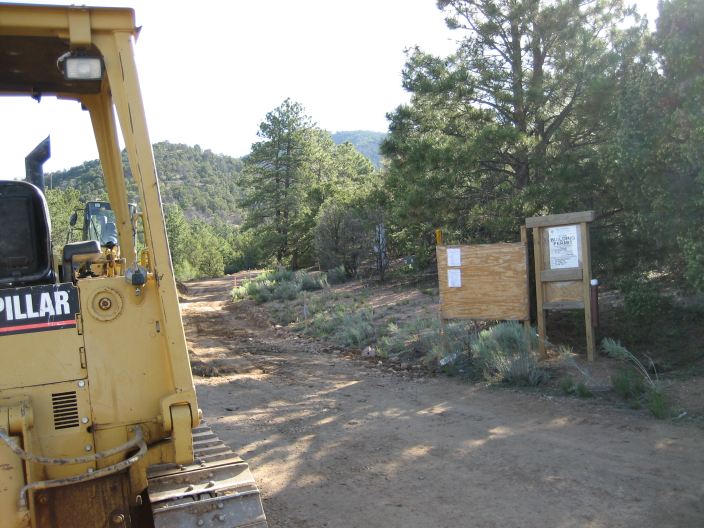
As I left my car and headed on foot through the Ponderosa Ridge subdivision I spotted Councilor Chavez returning from an early morning hike. As he leaned on his hand-carved walking stick, we talked politics -- the infighting that led to the loss of the Maloof donation, the prospects for a resurgence of Santa Fe Grassroots in next year's municipal campaigns. Last month he and Councilor Heldmeyer cast the sole votes against the Thornburg tax subsidy and both, should they decide to run, will be up for re-election.
Continuing up the mountain, I was surprised by a phalanx of yellow road graders and backhoes idled for the weekend. Ponderosa Ridge's developer, William Parker, another Santa Fe dentist who has ploughed his profits into real estate, quietly got permission from the city to cut a road across the Arroyo Mora, diverting it through a culvert, and up the hill on the other side. If the real estate market recovers we can count on two or three more foothill mansions.
Maybe that will be the end of it. Dr. Parker recently sold to the county, for more than $1 million and a tax write-off, a hundred almost vertical acres extending to the saddle between Talaya Peak and Atalaya Mountain. If energy and construction costs had remained stable this now undevelopable open space might have become Santa Fe's version of the Hollywood Hills.
June 20, 2007
Back to the River . . .
Later Sunday on my way to Home Depot, I detoured over the De Fouri Street Bridge and saw that the river was barely a trickle. By the time I reached Camino Alire it was gone. True to its word, the city is shutting off the flow leaving us to wonder how much longer the water would have lasted had it been parceled out more gradually. But that would have required some planning.
And suppose that the River Fund was already in place and citizens had purchased with their pocket change a million-dollar, fifty-acre-foot reserve. Is this the point where it would kick in, ensuring a few extra days of river? Or would the city just say, "Sorry. We've been releasing that water all along. It's gone." A plan like this would be better administered by an outside group like the Santa Fe Watershed Association -- one that is not beholden to the developers, that could demand delivery when it would do the most good.
After my installment of June 4, I heard from John Horning, the executive director of the Forest Guardians, objecting to my skeptical assessment of the checkoff plan. He made some good points -- that even if the program doesn't raise enough money to revive the river, it still would show that there is a constituency. That, he argued, would give groups like his the leverage to push for more aggressive steps, like demanding that the water we save from conservation be used for the river and not "to subsidize the next bit of sprawl." (Here, lest I not do it justice, is the full text of his email.)
My fear is that the opposite will happen, that in a town where water rates are already so high, only a handful of people will voluntarily pay more. Relieved by this tepid response, the city will have an excuse to maintain the status quo. I intend to sign up for the program, just as I intend to keep collecting water in my rainbarrels. But I've lost faith that these small gestures will lead to a noticeable change.
Getting the city's attention will require something more forceful -- finding an endangered species in the Santa Fe River watershed and filing a federal lawsuit demanding enough water for its survival. Or suing the city for mismanaging the municipal water supply -- for destroying public property (our parks, our cottonwoods), for endangering its own citizens by allowing the bosque to become a tinder box in the driest part of the summer. In the past conservationists have acquired grazing leases to keep them away from ranchers. Why not buy water rights to keep them away from developers?
. . . and the Graffiti Mess
Yesterday's New Mexican carried an AP story, Teens ready to buck the rule about the state's new law requiring children on skateboards and other wheeled conveyances to wear helmets. This is the kind of thing that makes Bill Waters, the paper's editorial page editor, apoplectic, and he obliges today with a predictably libertarian response. What struck me, however, was the photograph accompanying the original report: a 12-year-old skateboarding at the graffiti-ridden arena at Franklin Miles Park. The one downtown at De Vargas usually looks just as slummy -- a message from the city to Santa Fe's teens that spraypaint vandalism is o.k.

June 21, 2007
The scene yesterday on Tom Ford's hill
July 3, 2007
Two Quiet Victories
Nearly a year has passed since the Coss administration's failed attempt to replace three of the developers' favorite Planning Commissioners: Robert Werner, Eric Lujan, and Michael Trujillo. (Please see Chapter 25. Mayor Coss's Lost Gamble.) Last week he finally prevailed, loosening a finger of the grip the real estate industry has long had on City Hall.
An even bigger victory for the Mayor -- and the city as a whole -- came a day later with the outcome of a symbolic "no confidence" vote staged by a faction of the municipal workers' union. After all the grandstanding, union boss Len Montoya was able to round up only 20 percent of his members to cast ballots. They, unsurprisingly, opposed Mr. Coss, 2-1.
The Mayor was elected with strong support from organized labor, arousing fears that he would be overly beholden to the unions. By refusing to be strong-armed by a small core of inveterately disgruntled workers, he has raised his credibility with just about every one else.
His next test may come when the attempt to legalize short-term vacation rentals is voted on by the council. (For background on the issue, please use the search box at the bottom of this page.)
Here is what Mr. Coss promised voters last spring in a Q & A from the Canyon Neighborhood Association:
Q. Many residents have recently complained that the city's ordinance against short-term rentals is not being enforced. Would you take action to ensure that the law currently on the books is not weakened and that it is vigorously enforced? Please answer yes or no.
A. Yes. I will work to see that all codes are enforced and I will only support changes to our codes if those changes provide for better protection of our neighborhoods.
He has not yet made good on the first part of his promise, continuing to look the other way while companies like Management Group and Kokopelli profitably flout the law. If their attempt to overturn it (in the form of a measure sponsored by Councilor Wurzburger) results in stalemate, Mr. Coss will be called on to break the tie.
July 6, 2007
Promises, Promises
During the campaign, Councilor Chris Calvert was asked the same question as Mr. Coss -- whether he would (1) ensure that the current ban on short-term rentals be upheld and (2) demand that it be enforced. His answer was an unambiguous "yes" -- hence the concern of some District 1 constituents that he, along with the ever unpredictable Patti Bushee, may be wavering in the face of the real estate industry's onslaught.
But maybe it is naive to expect candidates to keep their promises. Councilor Wurzburger also answered in the affirmative (here again, is the questionnaire), then lost little time in leading the fight to overturn the law.
Meanwhile, with the City Attorney still refusing to enforce the ordinance, a reader has suggested what may be a more effective approach. Most if not all home mortgages have a clause specifically preventing rentals of any kind. (Commerical mortgages for investment property invariably come with higher interest rates.) Many operators of short-term rentals, who have no compunctions about running an illegal enterprise, are probably also lying to their mortgage holders -- meaning that they are in default. A visit to the County Clerk's office would reveal the name of the lender to whom concerned neighbors might choose to complain.

Addendum
Former City Manager Asenath Kepler has written to note that if one counts only members in good standing, the turnout for the union "no confidence" vote was 30 percent. She also pointed me to another take on the situation by my old college classmate Joe Monahan. Please scroll down to his entry for June 29th.

July 7, 2007
Broken Ground
Thornburg wasn't kidding when it said groundbreaking would begin around the end of June. Here are two photos from a reader, Jim Dulaney, taken from Ridgetop Road -- the first a year ago, the second today.

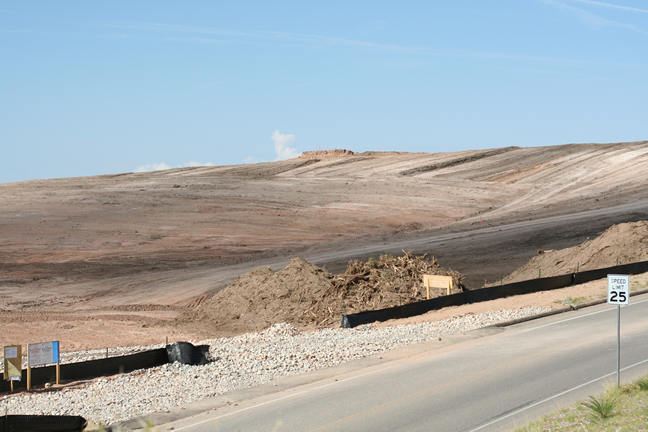
July 12, 2007
Mr. Wiviott
When I finally returned to New Mexico in 1992 after living for 14 years in Washington, Minneapolis, Los Angeles County, and New York City, I would go sometimes to Healy Matthews Stationers on Cerrillos Road -- the stretch downtown that doesn't seem like Cerrillos Road -- to purchase office supplies. I don't recall being inspired by the architecture, but I am no expert. When Don Wiviott, a developer with political ambitions, decided to put condominiums and a business complex on the site, the city's Historic Design Review Board balked, voting unanimously to impose some modest constraints. That is not what Mr. Wiviott wanted. He appealed to City Council, which obligingly ruled this week 7 to 1 in his favor.
Mr. Wiviott is, in subtle ways, the most effective kind of Santa Fe developer. Smarter than the run-of-the-mill Sinclair Lewis characters responsible for so much of Santa Fe's decline, Mr. Wiviott presents himself as a visionary. He is no mere profiteer but a provider of "infill development" and "environmentally friendly live/work spaces" -- trendy euphemisms for more aquifer-sapping, street-clogging construction. "We were green before they started calling people green," he says. Never mind that he helped underwrite the city council campaigns of Rebecca Wurzburger and Carmichael "Grassroots" Dominguez as well as David Pfeffer's quixotic Republican bid against Jeff Bingaman. More recently, aspiring to the Democratic nomination for U.S. Senate, Mr. Wiviott supported Garrett Thornburg's tax subsidy. That is what passes for progressive in Santa Fe.
***
Tonight the New Mexican's website has word on Mayor Coss's state of the city address. I'll be writing on that, maybe this weekend, once I catch up on work from my day job.

Coming forthwith: The Battle for Talaya Hill
The Andrew and Sydney Davis Webcam
Santa Fe Review Detours of the Wild West
The Santa Fe Review

More links:
See the current flow of the Santa Fe River above McClure Reservoir with the USGS automated gauge.
The Otowi gauge shows the flow of the Rio Grande north of Santa Fe.
Santa Fe water information, a collection of documents and links